Posted by R. John Howe on 05-20-2007 05:01 AM:
A Failed Inoculating Purchase
Dear folks -
Our participation in ICOC XI was part of a longer,
driving tour of Turkey. We arrived on 4/16 and came home on 5/14 and I had
decided early that I would refrain from much purchasing since I wanted to be
able to eat and sleep indoors during the last week of our stay. And my wife's
yurt-raising skills are somewhat atrophied since we both retired.
So I
decided to look around a bit before ICOC XI officially began and to make an
early, inexpensive purchase of something I liked, in the hope that it would have
a kind of inoculating effect. That is the background for what follows.
I
own a fragment of an embroidered Turkmen camel head dress that you have seen
before.


I like the holistic look of such a fragment and responded to
another that I encountered during our first walk-around the evening of April
16.

I've
rotated it 90 degrees below so you can look at it a bit more
closely.

As
I've examined this second piece I see things that make me ask questions about it
(although I still like it).
First, a dealer down the road from Istanbul,
looking at it indicated that it seemed not to have any visible places where the
other parts of the head dress fastened. He wondered whether it was a piece that
had been made, but not finished (that is, side straps had NEVER been put
on).
This made me look at the perimeter of the piece more closely and to
notice that the embroidery of the outside edge seems inferior to that in the
piece's interior. That seems especially to be the case of the strips that have
the X's on them. These X's are formed by single threads, something not
noticeable in the interior embroidery of the piece.
I now wonder whether
a newer outside perimeter may not have been fashioned to restore the original
piece the edges of which had become worn.
I still like its color and
graphics and it was very inexpensive, so if it is a mistake, it is not a costly
one. It's on the wall here and we can do direct scans of it, if there are
further suggestions or suspicions about it.
Oh. About it's inoculating
function. It worked fine during ICOC XI, in part because prices at the dealers'
fair were very high (despite this many dealers report that they did quite well),
but once the conference was over and we began our driving tour in the
country-side, its inoculating power failed completely.
This means that
there are other pieces to talk about, too. But first I invite thoughts and
comments about this one.
Regards,
R. John Howe
Posted by James Blanchard on 05-20-2007 12:54 PM:
Hi John,
I like that trapping, though I couldn't comment on its age.
How do the colours seem to you?
I think you have mistunderstood the
pathophysiology of rug collecting (cacoethesis lodicis?). An initial
exposure (rug purchase) does not serve to immunize against further purchases,
but rather starts an autoimmune reaction that soon develops a life of its own.
Only powerful immunomodulator therapy can get things back under control. Spouses
or significant others can perform this function, unless they too suffer from the
same immune dysregulation. Failing that, aggressive therapy can slow things down
for a while, like spending a lot of money on a fake (see the other thread).
Regardless, the condition is often progressive with frequent relapses. Happily,
sufferers of the condition are blissfully unaware of their
malady.
Cheers,
James.
Posted by Patrick Weiler on 05-20-2007 01:41 PM:
Booster Shot
John,
You neglected one of the standard procedures with vaccinations,
the Booster Shot.
I bought the kizil chuval pair the day before the
ICOC and then on the last day, at the Arasta Bazaar, purchased a single,
small item as a Booster Shot to strengthen the immunity.
This thread should
probably go on the Turkey I Bought in Istanbul thread, because both pieces were
purchased in Turkey - your head dress and this little immunity
booster:

As
you can obviously see, it is not in pristine condition. As a matter of fact, my
perception of perfection had probably been affected by the condition of so many
ancient, tattered Turkish textiles that this one appeared practically
intact.
What is it, you ask?
Well, on the ICOC cruise bus I showed it to
Jon Thompson, who agreed with my finding that it was probably woven by the
Boteh Tribe, NW Iran, 19th century.
It is 13" wide x 11" tall, 33cm x
28cm, with approximately 9x9 symmetric knots per square inch.

Here is a picture of the back,
where it is evident that, as I suggested in an earlier salon on Chanteh's,
whatever materials were at hand are used for these smaller pieces, along with a
variety of techniques quite likely for practice in use on larger
pieces:

These next two close-up shots are "upside down" compared to the
first two, because the pile as shown on the first two shots is in an upwards
orientation. These next two photos show the piece with the pile down. The light
blue and bright white knots are cotton:
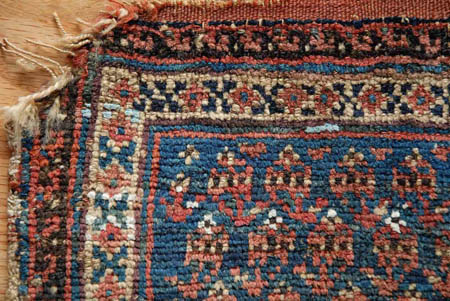
From the back, you can see that
there was cotton used also for the wefts in this area, along with a few
extra-weft inserts that extend for a couple of inches near the bottom of the
piece:
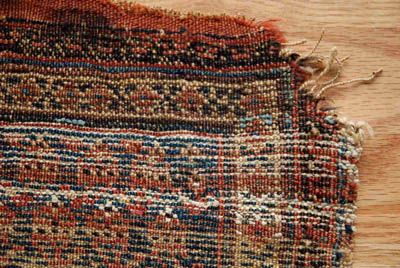
The
Booster Shot worked, because other than trinkets for gifts back home, these were
all the weavings I bought in Turkey!
Patrick Weiler
Posted by Richard Larkin on 05-20-2007 05:14 PM:
Hi Patrick,
I don't mean to nitpick, but I note the piece is only 11
inches tall in certain places. 
If I recall my research correctly, the Boteh tribe is not
indigenous to Turkey, and are limited to a small group forcefully resettled
there by Othman I to perform certain customs functions at the airport. That
would seem to indicate that the Turks imported this piece of yours and others of
its ilk. Coals to Newcastle, if you ask me.
__________________
Rich
Larkin
Posted by Chris Countryman on 05-20-2007 09:26 PM:
Resistance resource depletion
Greetings John and all,
Your attempt at resisting purchases by buying
early actually has some scientific basis. In a recent article entitled "Spent
Resources: Self-Regulatory Resource Availability Affects Impulse Buying," the
authors talk about how people resist initial temptations and then, when their
self-control resources are depleted, spent more on impulsive purchases.
This is why the supermarkets put some of their junkiest food up
front--you may resist that but you will buy other stuff later.
Basically
what this means is that we ruggies are doomed. As your and Pat's pics prove,
there are too many treats at these rug conventions to keep up the resistance
forever. My recommendation is a version of what Pat did: buy small things at
regular intervals. At least then you can tell the wife that you were saving your
"self-regulatory resources" to keep yourself away from the junk food.
Maybe a new motto for the rug world would be appropriate: "Buy wisely,
buy often."
Chris
__________________
Chris
Countryman
Posted by Patrick Weiler on 05-21-2007 12:40 AM:
Rabid Rebuttal
Richard,
I am measuring this piece diagonally, just like televisions,
so the 11" measurement is accurate!
The resettlement of the Boteh Tribe
to Turkish airport customs jobs could possibly explain why such a valuable piece
was allowed to exit the country - it was seen as an opportunity to advance their
cause of independence.
They want admittance to NATO and the European
Union.
Chris,
Who is saying anything about resisting initial
temptation? I bought both the kizil chuvals and this chanteh immediately upon
the first moment of inclination. And if the supermarkets hid their junk food
behind the counter, with brown paper wrappers, I would hunt it down and purchase
it mercilessly.
So putting the cheap, crummy fragments and late, decrepit
rugs on top of the pile doesn't stop me. I have a whole collection of the stuff,
waiting for it to appreciate in value just like the Enron stock I bought for
$200 a share...
And John, that second piece you bought, it's not a camel
head dress, it is a loincloth...
Patrick Weiler, late, very late,
Sunday night.
Posted by Chuck Wagner on 05-21-2007 07:32 AM:
A Trapping Fragment
Hi John,
I like your new piece. I don't think you should waste any
more time looking for strap attachments - this is probably part of one of those
large composite trappings that are a little more typical of Yomut work. I think
this is equally true for your first piece as well.
I don't have an image
handy - I'll try to find one - I'm talking about the ones that have a
rectangular lattice of diamond shaped pieces along each side that drape the side
of the neck, that are attached to each side of a long rectangular central panel
that rides along the top of the neck.
Your piece would be the part
stitched to the end of the central panel such that it would drape over the head.
The quality of the embroidery work is reminiscent of that little antique
tobacco-pouch/coin-purse/cell-phone-case I showed a while back:
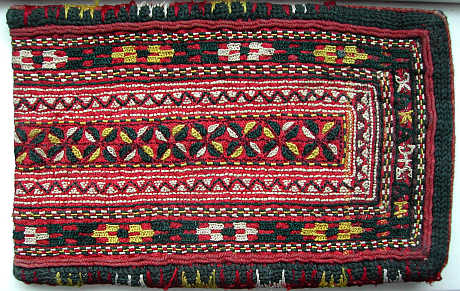
Edit: Hah ! I
found an image. In this one, it looks like the/your head cover has slipped back
down the neck. Is it possible that this is one of those ornery uncooperative
camels that are rumored to exist ?:

Regards,
Chuck
Wagner
__________________
Chuck
Wagner
Posted by James Blanchard on 05-21-2007 10:55 AM:
Hi all,
I recently saw a very large Turkoman camel trapping that
included a head piece, and extended back to a large back piece with a
rectangular opening for the hump, and had a bunch of silk diamonds sewn together
to hang down along the side. It was intriguing, but since I don't own a camel,
and our dog is a bit small for that and only tolerates getting dressed up by our
daugthers at Halloween, it was hard to think how one might display
it!
Unfortunately, I didn't have my camera on my last trip so I was
unable to get a photo of it. Maybe I can get it a picture next time, or have
someone send it to me. It was an interesting piece.
James.
Posted by Steve Price on 05-21-2007 11:04 AM:
Hi People,
Here's one that's nearly complete (the camel is
missing):

It appeared on Turkotek about 7 years ago, when we were
reluctant to post larger images because of the limitations of our server space
and of the computers our readers used. For a little discussion about it, here's
the link:
http://www.turkotek.com/salon_00036/s36t2.htm
Regards
Steve
Price
Posted by James Blanchard on 05-21-2007 11:06 AM:
Thanks Steve. That was fast!
That is very similar to the one I saw. As
I recall, the one I saw had a larger back panel with a rectangular
opening.
James.
Posted by James Blanchard on 05-21-2007 11:08 AM:
By the way, the Salon/discussion referenced by Steve mentions locks of hair
sewn onto the trapping. The one I saw had that too. Curious...
James.
Posted by R. John Howe on 05-21-2007 11:08 AM:
Some Similar Pieces
Dear folks -
I've seen a number of fragments such as the one with
which I began this thread. Here it is again for ease of comparison.

Now, I think this piece
is interesting, not an embarrassing acquisition but I do not think it has the
aesthetic quality of the similar piece (below) that I purchased several years
ago.

Peter
Andrews and a German collector of Turkmen embroideries, opined that they had not
seen the design on this second piece before. So it is, at least, that
unusual.
Nor would I claim that my first piece is nearly on the same
level of aesthetics as some other examples of which I know.
Here are
three pieces included in Jeff Spurr's exhibition at ACOR in Boston (they may be
in Jeff's collection as well).
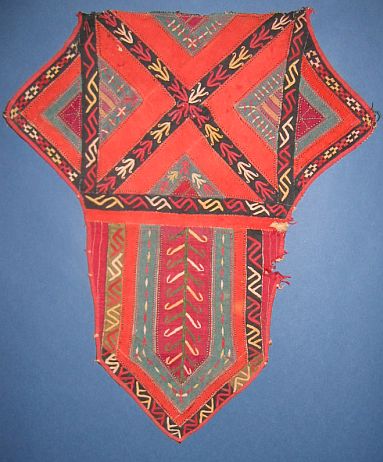

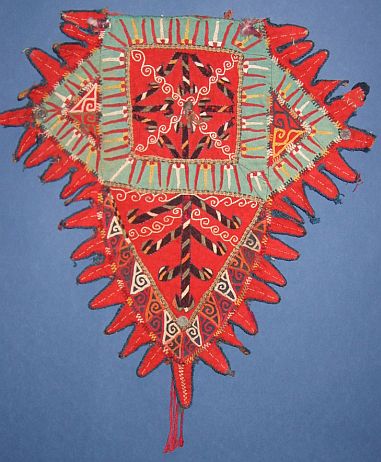
I think these latter three
pieces are among the best of this sort that I have seen and are at a different
level entirely than the modest little piece I have just purchased.
Just
so you can examine for yourselves, some of the different sorts of items that
reside in this format grouping and can see that I am realistic about what I have
bought in this instance.
Regards,
R. John Howe
Posted by Sue Zimmerman on 05-21-2007 11:29 AM:
James, In Mongolia the first camel born of the season gets a special trapping
that includes a lock of it's father's beard hair. Sue
Posted by James Blanchard on 05-21-2007 11:35 AM:
Thanks, Sue.
These locks were not camel. In fact, they looked and felt
like human hair.
James.
Posted by Sue Zimmerman on 05-21-2007 12:03 PM:
You're welcome, James,
The outer coat of good quality camel hair is
almost identical in qualities to good quality human hair. I've spun both. In the
US, at least, it is impossible to import good camel hair because it is destroyed
by the processing required to assure it doesn't carry anthrax into the country.
I have some imported camel hair of that sort and it doesn't resemble good
quality human hair at all. Sue
Posted by James Blanchard on 05-21-2007 01:49 PM:
Well, I haven't met any camels with that sort of hair, but maybe I don't know
any fine-haired camels. The ones with which I am familiar seem a bit more
grizzled. Moreover, this hair was almost black in colour.
Someday I could
recount a great (and true) story from the Sind desert about a male camel in
"heat" and a VW Beetle with a sun-roof and a faulty starter. Male camels "in
heat" are generally kept separate from female camels so they can get a bit
"desperate", and they foam at the mouth prodigiously.  (actually, I guess there is not much more
to say...)
(actually, I guess there is not much more
to say...)
James.
Posted by Steve Price on 05-21-2007 01:53 PM:
quote:
Originally posted by James Blanchard
Someday I could recount a
great (and true) story from the Sind desert about a male camel in "heat" and a
VW Beetle with a sun-roof and a faulty starter. Male camels "in heat" are
generally kept separate from female camels so they can get a bit "desperate",
and they foam at the mouth prodigiously.  (actually, I guess there is not much
more to say...)
(actually, I guess there is not much
more to say...)
James.
Hi James
It conjures up quite an image.
Steve
Price
Posted by Richard Larkin on 05-21-2007 04:29 PM:
Truth in measurement
Patrick,
All I can say is, if you had been a boxer, they never woulda
laid a glove on you. And as much as it kills me to say it, I like your piece, at
least, what's left of it. I secretly approve of the "buy junk" method of
collecting, and I can attest to the truth of your report on the results (i. e.,
a vast collection of junk).
__________________
Rich
Larkin
Posted by Gene Williams on 06-01-2007 07:09 PM:
MAD
Chuck, Richard, James,
Question: Is that James' MAD Ersari rug drapped
over the camel?
Gene
Posted by James Blanchard on 06-01-2007 10:14 PM:
Don't think so...
Hi Gene,
That looks like a Yomut asmalyk on the side of the camel. I
imagine there is another similar one hanging on the other side. But my MAD
Ersari does have an faint odour that could be camel... It intrigues our
dog.
James.
Posted by Steve Price on 06-02-2007 07:26 AM:
Hi Gene
It does look like a Yomud asmalyk, and it appears to be on the
bride's camel. She's probably in the kejebe, the tent-like thing on the
camel. It's too bad the photo isn't better and in color - there are a number of
interesting textiles on or around the kejebe, including some that look like they
might be what we usually call tent bands.
Regards
Steve Price
















 (actually, I guess there is not much more
to say...)
(actually, I guess there is not much more
to say...)